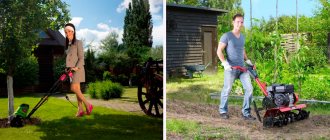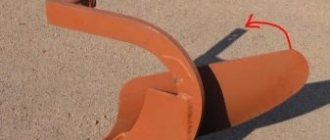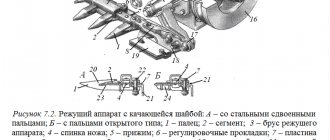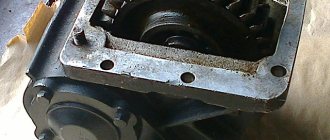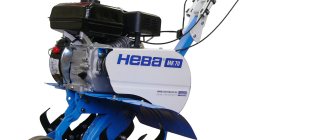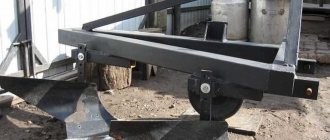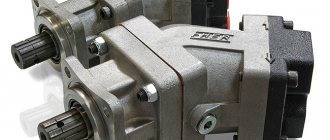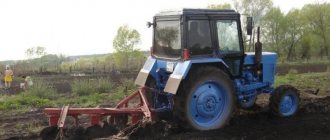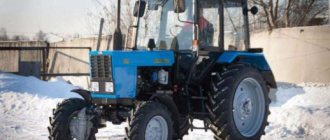Tractor plow
A plow is an agricultural machine designed for plowing (the main type of soil cultivation). During plowing, the working parts of the plow crumble layers of soil, wrap them and dump them at the bottom of the formed furrow. At the same time, all stubble residues and weeds are embedded deep into the soil. Plowing is carried out to a given depth (from 18 to 35 cm) within certain agrotechnical periods.
Plow classification
The classification of arable units is carried out according to the following criteria:
- By purpose:
- General purpose plows equipped with working bodies having a standard working width (35 cm). They are intended for processing old arable soils for sowing industrial, vegetable and grain crops.
- Special purpose arable units. These include planting plows PPN-50 and garden plows PS-4-30; for processing rocky soils PKU-4-35; shrub-marsh PBN-75 and PBN-100A; for vineyards PPU-50A; longline PTN-40 and PTN-3-40 for plowing chestnut and solonetz soils.
- By type of connection to the tractor:
- Trailed
- Mounted
- Semi-mounted
- By type of working body:
- Disk
- Ploughshares
- By number of buildings:
- One (horse)
- Multi-hull (PON-2-30, PLN-3-35, PTK-9-35)
- According to the technology of work execution:
- For smooth (spring) plowing
- For fall plowing (fall plowing)
Share steel
For the production of shares, two grades of steel L 65 and L 53 are used with the following content of alloying elements in their composition:
| steel grade | Carbon | Manganese | Silicon | Sulfur | Phosphorus |
| Content in % | Content in % no more | ||||
| L 65 | 0,6-0,7 | 0,3-0,6 | 0,15-0,4 | 0,05 | 0,045 |
| L 53 | 0,47-0,59 | 0,5-0,8 | 0,15-0,4 | 0,05 | 0,05 |
The hardness of steel of these grades should not exceed 255 NB (Brinell)
Scientific experiments have shown that the use of C-carbon in the alloy composition from 1.5 to 2%, Si-silicon from 2 to 6% with the addition of V-vanadium and Cr-chrome from 1.5 to 2% ensures an increase in the working life of the share from 30 to 50%. However, in practice, the above metal alloying is not used due to the significant increase in the cost of the material.
General structure (diagram) of a plowshare plow
The arable unit consists of auxiliary elements and working parts mounted on a common frame. Auxiliary elements are designed to facilitate the work. They include support wheels (one or two), furrow wheels (for semi-mounted and trailed plows), a tillage depth adjustment mechanism, a trailing device or a hitch mechanism. The working parts include a knife, a skimmer with a subsoiler and the main body.
Working bodies
The knife is used to cut a vertical layer of soil, facilitating the entry of the body into the ground. It helps level the sulcus wall. General-purpose arable units are equipped with disc-type knives. Special plows used for cultivating heavy soils are equipped with handle-type knives.
The main body of the plow is designed to remove the soil layer, crumble it, wrap it and lay it on the bottom of the furrow. Its device includes a ploughshare, a blade and a field board mounted on a stand. The ploughshare cuts the soil layer. Plows can be equipped with trapezoidal, chisel-shaped, cut-out, with a cheek or a retractable chisel. The blade wraps the cut layer and drops it to the bottom of the formed furrow. Based on the type of blade, the bodies are divided into:
- Cultural - for the main cultivation of old arable soils;
- Half-screw - for plowing soddy soils;
- Cut-out - for cultivating lands with a thin fertile horizon;
- With a retractable chisel - for processing heavy clay soils and loams;
- With a subsoil paw - for plowing and simultaneous loosening of the subsoil layer of chestnut and podzolic soils;
- Disc - for processing heavy, root-choked trees or waterlogged soils;
- Rotary (rotating) - for preparing soils for crops, the cultivation of which requires high quality processing.
- Combined - for plowing with intensive grinding of the cultivated soil layer;
- Non-mouldboard - for preparing for sowing lands destroyed by wind erosion in arid regions. Plows with such a moldboard are called chisel plows.
The field board ensures the evenness of the plow body, preventing it from turning under the reaction of the soil. The body stand can be low (for processing heavy, abandoned soils) and high (for soft, cultivated soils). They are made by stamping. Each rack has a special saddle for attaching the housing.
The skimmer is designed to cut and crush the top layer of soil. It is designed similarly to the main body, but is smaller in size. Its working width is one third less than that of the main body.
Auxiliary parts
Depending on the type of connection between the arable unit and the tractor, the auxiliary parts have a number of distinctive features.
- A mounted plow has a frame welded from transverse, longitudinal and main hollow beams. Its device includes one support wheel equipped with a screw adjustment mechanism. The cross beam is equipped with an SA-2 automatic coupler, through which the arable unit is mounted on the tractor.
- The frame of semi-mounted plows consists of hinged hollow beams. Their equipment includes two support wheels, a transport mechanism with a pair of pneumatic wheels (field and furrow) and an automatic coupler.
- The design of trailed plows includes a device for connecting to a tractor and three pneumatic wheels: a furrow wheel, located in the area of the first body; field, located in the middle part of the plow and rear.
Methods for increasing working life
In terms of studying methods for increasing the working life of plowshares, a lot of experiments have been carried out in the scientific community, most of which are associated with rather complex technological processes that require expensive material base in production equipment and materials. The list of technological methods includes:
The main part of the above production methods has not been widely used in optimizing soil-cultivating technological operations in the agricultural sector due to the unreasonably expensive cost of such products.
Connection to tractor
To attach a trailed plow, the tractor has a special linkage to which the coupling device of the plowing unit is attached. Mounted and semi-mounted arable units are connected to the tractor via an automatic coupler, consisting of a frame and a lock. The lock, made of two channels inclined at an angle of 65° to each other, is securely fixed with a bolt on a brace welded to the plow frame. The frame is fixed with a pin to the lower arms of the tractor hitch mechanism and with the help of a cheek to the upper link. The lock and frame are supported by a special pawl connected to the cabin by a cable. This allows you to unhook the plow without leaving the cab. The connection of mounted plows to the tractor is usually carried out using a two-point connection. Semi-mounted, wide-cut multi-furrow plows are mounted using a three-point system.
Application of wear-resistant coatings
To increase the working life of the ploughshare, the most accessible and applicable in practice are surfacing methods using electric arc welding or a gas flame torch. The working material for surfacing is the high-strength composition “Sormite”, which is available on the market in the form of special electrodes for electric arc surfacing.
Electrode grades for carbide surfacing Sormite: T-590, T-600, S-1, PR-S27.
Surfacing is carried out in an even strip without breaking the deposited layer along the cutting edge. To cover 1 cm², 1-1.5 grams of alloy are consumed.
Features of special-purpose plows
Special-purpose plows are equipped with working bodies of a special design, allowing soil cultivation under specific conditions.
- Shrub-marsh plow PBN-75/PBN-100A. Its device includes one housing with a working width of 75 or 100 cm, disk; flat, equipped with a support ski, or a cutting knife, a linkage mechanism and a support wheel. Used for plowing drained mineral soils and peatlands, previously cleared of small shrubs from pastures and meadows.
- Reinforced plows for preparing for sowing rocky soils. They are equipped with automatic (PKU-4-35) or hydropneumatic (PGP-7-40, PKG-5-40) fuses. When hitting a tree root or stone remaining in the ground, the fuse is triggered and the body is pulled out of the soil. Having passed it, under the influence of the traction force of the tractor, the body is again buried in the ground.
- Longline plows PTN-40 and PTN-3-40. They are used when necessary to increase the depth of the subsoil horizon when cultivating depleted soils (podzolic and solonetzic), as well as to prepare land for planting garden trees, vineyards and cotton. In three-tier plowing, the first body cuts the top layer and dumps it to the bottom. The second body lifts the lower layer along with the upper layer laid on it, but does not wrap it around, but moves it to the side, forming a furrow. The second layer of soil removed by the rear body is dumped onto it. Double-tier plowing can be done in two ways. In the first case, the top layer falls onto the surface of the plowed area, and the bottom and middle layers are loosened and mixed. In the second case, the middle and lower horizons are brought to the surface, and the upper one is buried at a given depth.
- Single body plow. Used for cultivating light fertile soils in garden plots.
